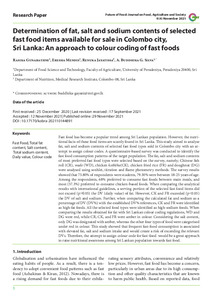| dc.date.accessioned | 2022-01-11T10:55:46Z | |
| dc.date.available | 2022-01-11T10:55:46Z | |
| dc.date.issued | 2021-11-29 | |
| dc.identifier | doi:10.17170/kobra-202110144891 | |
| dc.identifier.uri | http://hdl.handle.net/123456789/13501 | |
| dc.language.iso | eng | eng |
| dc.rights | Namensnennung 4.0 International | * |
| dc.rights.uri | http://creativecommons.org/licenses/by/4.0/ | * |
| dc.subject | fast food | eng |
| dc.subject | total fat content | eng |
| dc.subject | salt content | eng |
| dc.subject | total sodium content | eng |
| dc.subject | daily value | eng |
| dc.subject | colour code | eng |
| dc.subject.ddc | 300 | |
| dc.subject.ddc | 630 | |
| dc.title | Determination of fat, salt and sodium contents of selected fast food items available for sale in Colombo city, Sri Lanka: An approach to colour coding of fast foods | eng |
| dc.type | Aufsatz | |
| dcterms.abstract | Fast food has become a popular trend among Sri Lankan consumers. However, the nutritional facts of these food items that aid consumer awareness are scantly found in Sri Lanka. This study aimed to examine fat, salt and sodium contents of selected fast food types sold in Colombo city. A questionnaire-based survey was conducted to identify the fast food consumption patterns of the target population. Fat, salt and sodium contents of highly preferred fast food types selected based on the survey, namely; Chinese fish roll (CR), wade (WD), chicken koththu(CK), chicken fried rice (FR) and doughnut (DG) were analysed using Soxhlet, titration and flame photometry methods respectively. Comparative analysis of lipid extraction between Soxhlet and Soxtec were done for selected fast food samples. Based on the survey, 73.30% of respondents were students, 79.30% were in between 18-25 years and 68% preferred to consume fast foods in between main meals. According to the results, a serving portion of these food items did not exceed (p˃0.05) the RMDA (recommended maximum daily allowance) of fat. However, CK and FR have exceeded (p˂0.05) the RMDA of salt and sodium. When comparing the results obtained for fat with the colour coding system under the food act, WD and DG were assigned red while CR, CK, FR were assigned amber colour. Considering the salt content, only DG was designated by amber colour whereas other four types of food is in the category of red colour. There was no significant difference (p˃0.05) between Soxtec extraction at 130 ºC and Soxhlet extraction at 70 ºC. Therefore, The Soxtec extraction was time effective where high temperature fat extraction was applicable. Frequent consumption of the fast food can lead to exceed RMDA values of fat, salt, sodium and calories. Holistic policy intervention is warranted to minimise the risk of frequent consumption of fast food. | eng |
| dcterms.accessRights | open access | |
| dcterms.creator | Gunarathne, Rasika | |
| dcterms.creator | Mendis, Eresha | |
| dcterms.creator | Jayatissa, Renuka | |
| dcterms.creator | Silva, A. Buddhika G. | |
| dc.subject.swd | Sri Lanka | ger |
| dc.subject.swd | Fast Food | ger |
| dc.subject.swd | Fettgehalt | ger |
| dc.subject.swd | Salzgehalt | ger |
| dc.subject.swd | Natrium | ger |
| dc.subject.swd | Lebensmittelkennzeichnung | ger |
| dc.type.version | publishedVersion | |
| dcterms.source.identifier | eissn:2197-411X | |
| dcterms.source.issue | No. 4 | |
| dcterms.source.journal | Future of Food: Journal on Food, Agriculture & Society | eng |
| dcterms.source.volume | Vol. 9 | |
| kup.iskup | false | |
| dcterms.source.articlenumber | 418 | |


